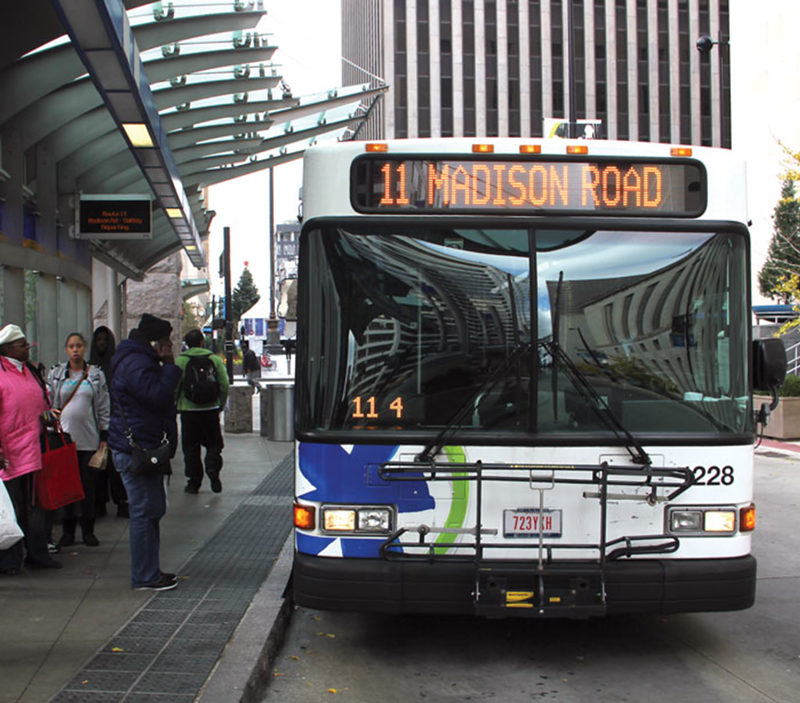On a recent blustery November day, Michelle Collier waited at a downtown bus stop where her kids would soon be arriving from school on a Metro bus. Collier spends a lot of time on Metro — she lives in Price Hill but takes the bus to jobs she works in Avondale and at the Kenwood Towne Centre.
“It could be a lot better,” she says of her daily commute.
The 15-mile bus ride to her job at the mall takes about an hour and a half each way, including a time-intensive transfer from the 4 to the 33 route, meaning she has to get up extra-early on mornings when she works there. She says she’d like to buy a car eventually, but can’t afford one at the moment. Until she can, Collier is one of the thousands of Cincinnati residents dependent on Metro for transportation to work, school, the grocery and other vital trips. Many of these riders endure long routes that don’t go where most of the jobs and other necessities in the city are located, thanks to a transit system that ranks lowest among cities similar to Cincinnati for connection to jobs. The city’s lagging transit system places extra barriers in the way of the city’s low-income residents and might be keeping more young professionals from moving here, transit advocates say. But funding transit in Cincinnati remains complicated and controversial, and current transit improvements now underway might not lift all residents equally.A recent study of Metro’s reach commissioned by the Cincinnati USA Regional Chamber, the Urban Land Institute and other organizations found that only 23 percent of jobs in the city are easily reachable by public transit.
Many others take more than 90 minutes to reach by bus. And about 40 percent of jobs in the city — some 75,000 — aren’t reachable by transit at all. All told, the city ranks lower than 11 other peer cities when it comes to job accessibility via public transit., including regional neighbors Louisville, Indianapolis, Cleveland, Columbus and Pittsburgh as well as cities elsewhere like Denver and Austin.Cincinnati City Councilwoman Amy Murray, chair of Council’s Major Transportation and Regional Cooperation Committee, said at a Nov. 10 panel discussion on the transit report that she was “shocked and disappointed” by the study’s findings. Murray, a Republican, touted a county-wide sales tax increase that might be on next year’s ballot as a way to expand services offered by the Southwest Ohio Regional Transit Authority, which runs Metro.
“We need to expand Metro and get people to work,” Murray said.
The lack of connectivity compounds difficulties for low-income residents and others who cannot or do not want to drive. Walmart employee La’Randa Jackson, for example, told CityBeat earlier this year about her hour-long bus commute, which requires a transfer to get her to work 3.5 miles away.
( See “Loose Change,” issue of Jan. 14 ).Lack of connectivity also makes it hard for those living in food deserts to get to grocery stores, as Northside resident DeBorah Reed told CityBeat this summer (see “Better Together?” issue of July 15). Reed takes the numbers 16 and 17 to travel two miles to the Kroger on Kenard Street. She says she often has to wait up to 20 minutes to catch her transfer.
But shoring up SORTA’s services is also about attracting new residents, increasing development and underlining Cincinnati’s status as a revitalizing city, advocates say. Former Zipcar vice president and transit expert Gabe Klein gave the keynote address at the Chamber’s regional connectivity panel Nov. 10. He says the key to rebuilding the city’s density (and its tax base) and attracting young professionals is to boost public transit options.“We tore the heart and soul out of our cities,” Klein told the packed house that had gathered for the event on regional transit. Klein tied Cincinnati’s precipitous decline in population — which peaked around 1950 at 500,000 — with the construction of highways and the removal of the city’s streetcars. The last car ran in 1951.
Today, Cincinnati is benefiting from the renewed interest in urban living by young professionals and older, well-heeled homebuyers. The city’s population is rising again slightly, topping 300,000 in Census estimates last year. And in some center-city neighborhoods, like Over-the-Rhine, the population spikes are even more noteworthy. But the same can be said for other cities like Pittsburgh, which has a more developed transit system and which is drawing young professionals back to its downtown at twice the rate Cincinnati is, according to the Chamber report. Transit advocates say that’s at least in part because transit helps cities attract new economic development and young, less car-centric residents.“The majority of younger people will not move here if it’s a car-driven place,” Klein said. “It’s an economic development strategy. It’s the only way to save your city.”
Nationally, research suggests that transit spending might pay economic dividends. A study by the Economic Development Research Group, a Boston-based institute that studies development, found that every dollar spent on transit projects led to four to nine dollars in tax receipts and other benefits from economic development around the transit projects.
That study doesn’t shed light on how the Greater Cincinnati area specifically might benefit from a boost in transit, but some claim projects like Cincinnati’s controversial streetcar are already bearing fruit.
The $130-million project has been the source of seemingly unending political battles since it began in 2011. Some opponents say the cost is too steep. Others point out that the 3.6-mile loop around Over-the-Rhine and downtown doesn’t really serve a transit function for most Cincinnati residents, especially the low-income.
Proponents of the system point out that the streetcar project has sparked property development projects along its route and that at least a few major employers have cited the project as among the reasons they’re bringing more jobs to the city.
One major project at least partially influenced by the streetcar is General Electric’s new global operations center at riverfront development The Banks. The center is expected to bring at least $300 million in investment to Cincinnati’s riverfront, along with up to 2,000 mostly high-wage jobs.
The federal government also seems to think Cincinnati’s streetcar project has economic development potential. In 2011, the U.S. Department of Transportation awarded the city $10.9 million in Transit Investment Generating Economic Recovery (TIGER) grants for the project.
But there could be a downside to streetcar-style transit projects, one that exacerbates the struggles of low-income city residents most dependent on Metro.
New development along the streetcar route in OTR has sparked fears of gentrification. As property values go up in the historically low-income neighborhoods where development-generating transit projects take root, long-time residents can be displaced.
Even some streetcar boosters seem to acknowledge this risk. Vice Mayor David Mann touted Portland’s streetcar system in a 2014 Cincinnati Enquirer editorial, saying it brought a bevy of economic development deals. But he also nodded to problems there.
“Portland has seen gentrification of the downtown area,” Mann wrote in the piece, acknowledging that the city’s streetcar may have played a role in that dynamic.
There are signs gentrification is also happening in OTR.
Data from the 2013 American Community Survey by the U.S. Census Bureau shows median incomes are rising in that neighborhood and that the number of low-income and minority residents has decreased in the southern portion of the neighborhood (see “Moving Up, Moving Out,” issue of Aug. 12).
That change certainly isn’t all about the streetcar, and might not even be entirely about gentrification. But some wonder if the transit project could contribute to shuffling some off to neighborhoods farther away from the center of the city where transit options are still less than optimal.
Recent improvements to Cincinnati’s bus system, including beefed-up routes, updated bus stops and neighborhood transit hubs in places like Clifton and Northside have helped Metro better serve bus riders in those neighborhoods, and a funding boost like one that could come with next year’s ballot would as well. But change is complicated.
A recent proposal by Metro to run smaller buses into under-served neighborhoods sparked strike threats from SORTA’s union. SORTA wants to pay those drivers less because the smaller buses don't require commercial drivers licenses. The union thinks its drivers should run those routes at regular union pay rates.
Meanwhile, as the transit provider wrestles with how to expand, some riders continue to face a long wait. ©






